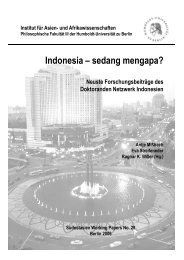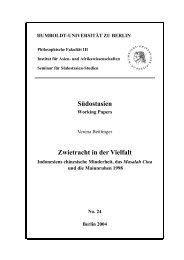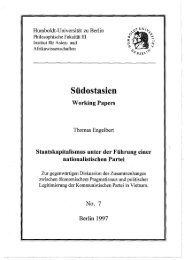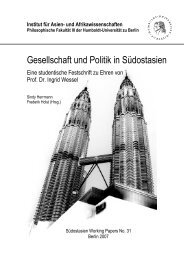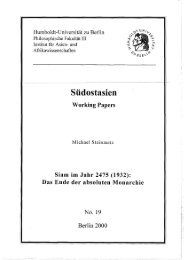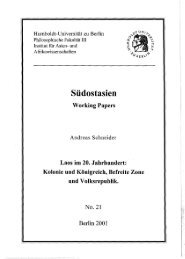On Centrism and Dualism - Humboldt-Universität zu Berlin
On Centrism and Dualism - Humboldt-Universität zu Berlin
On Centrism and Dualism - Humboldt-Universität zu Berlin
You also want an ePaper? Increase the reach of your titles
YUMPU automatically turns print PDFs into web optimized ePapers that Google loves.
CENTRISM AND DUALISM<br />
other, hence the story as a whole can be thought of as being a ‘palimpsest’ 37 of superimposed<br />
<strong>and</strong> homologically related metaphoric transformations.<br />
The analyst who seeks to decode the message embodied in the myth as a whole (which is<br />
different from the surface messages of the respective episodes) must look for a pattern of<br />
structure (of a somewhat abstract kind), which is common to the whole set of metaphors. In<br />
its initial state the mythical story st<strong>and</strong>s in a linear form, one thing happening after another.<br />
The mythical events unfold in sequence, forming a syntagmatic chain, being linked by<br />
metonymy. The analyst has to identify the meaningful points, where the myth can be broken<br />
up <strong>and</strong> arranged into episodes. These episodes are thought of as being partial transformations<br />
of one another. The episodes are then rearranged <strong>and</strong> their relationship is considered as being<br />
metaphoric. So metonymy has to be converted into metaphor. The results are abstract<br />
elements, which need to be summed up <strong>and</strong> read again as a syntagmatic chain. This final<br />
switch from metaphor to metonymy brings about the overall meaning of the myth. The analyst<br />
has to make a double switch from the metonymic mode to the metaphoric <strong>and</strong> back again<br />
(ibid.: 25-26).<br />
In summary, the task of the analyst wishing to unravel the meaning of a myth lies in breaking<br />
up the myth as a whole <strong>and</strong> rearranging the emerging elements under the premises of<br />
metonymy <strong>and</strong> metaphor. 38<br />
LEACH indicates that the heuristic value of LÉVI-STRAUSS’ technique of myth interpretation is<br />
not confined to mythology, but is of general importance for the anthropological study of, e.g.<br />
ritual activity. Since all utterances are sequences in time they are, by their very nature <strong>and</strong><br />
similar to myths, syntagmatic chains of message bearing elements. <strong>On</strong>e important aspect of<br />
most verbal messages is that they are synchronic: the end is implicit in the beginning <strong>and</strong> vice<br />
versa. The time interval between the beginning of the utterance <strong>and</strong> the end is so short that we<br />
are liable to forget that any time factor is involved at all. By contrast, ritual performances are<br />
often diachronic, separated by a considerable amount of time. This time span separating one<br />
element of the performance from another makes us liable to forget that these two elements<br />
belong to the same ritual complex, hence constituting a single message (ibid.: 26-27).<br />
37 A palimpsest is a manuscript page that has been written on, scraped off, <strong>and</strong> used again. In common usage the<br />
word st<strong>and</strong>s as a metaphor, negating author’s claims for exclusive originality, by underlining that writing exists<br />
only in the presence of already written.<br />
38 For a practical example of LÉVI-STRAUSS’ ‘celebrated technique of myth interpretation’ I would like to point<br />
to his essay The Story of Asdiwal (LÉVI-STRAUSS 1967a), where he analyzes a Tsimshian Indian myth, which<br />
LEACH identifies as “[…] the most successful piece of structural analysis of myth prior to the appearance of his<br />
The Raw <strong>and</strong> the Cooked.” (LEACH 1967: 1) LÉVI-STRAUSS interprets the myth of Asdiwal as functioning to<br />
reconcile the contradictions inherent in matrilineal descent combined with patrilocal residence (cf. DAVIS 1974:<br />
8).<br />
20



